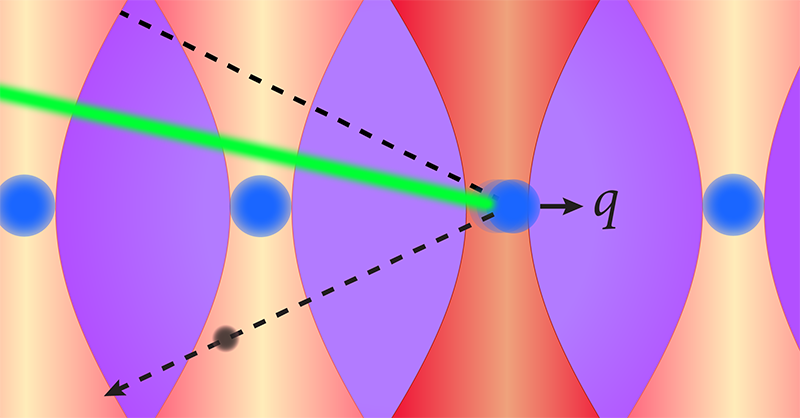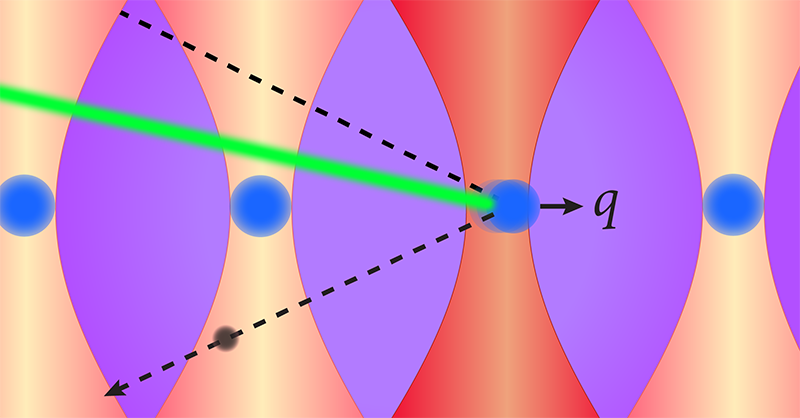Dark Matter Meets Atomic, Molecular, and Optical Physics
Dark matter accounts for roughly 85% of the total mass in the Universe, yet its constituents remain unknown. Solving this mystery calls for a wide range of experiments that can detect dark matter constituents with different masses and interactions. Now, Gadi Afek at Yale University and colleagues have proposed a laboratory-based detector that is drastically different from existing experiments [1]. The detector works by measuring the momentum imparted when dark matter particles scatter off optically trapped nanometer-scale spheres. This approach provides an entirely new way to search for light dark matter particles with masses down to fractions of the mass of an electron.
For decades, experimental approaches for detecting dark matter have been driven by theory. Hypothetical particles called weakly interacting massive particles (WIMPs) were a byproduct of many theories developed to extend the standard model of particle physics. WIMPs remain viable and well-motivated dark matter candidates with masses above about 1 (roughly the mass of a proton). Other hypothetical particles known as axions remain attractive dark matter candidates for a range of masses below 100 .
Decades of searches for WIMPs and axions have so far come up empty handed. However, the next few years will see many experiments—such as ADMX [2], LZ [3], and XENONnT [4]—with the sensitivity to cover much of the expected parameter space for these particles. This statement is by no means trivial: it took decades of vigorous technological development to get to this point. But what if dark matter is not WIMPs or axions? What other possibilities are there, and what opportunities arise for both theoretical model building and novel experimental approaches? Clearly, the significance of the dark matter problem mandates scientists to evaluate other concepts and cast the widest possible net.
For this reason, there have been new proposals and new experiments that extend the detection sensitivity to other dark matter interactions and mass ranges. Notably, for WIMPs, dedicated experiments—including SENSEI [5], CRESST [6], and SuperCDMS [7]—search for dark matter in the mass range below a few . These experiments use extremely sensitive particle detectors, ranging from CCD chips to cryogenic calorimeters. Preliminary work has also been carried out on, for example, detectors containing superfluid helium that can discern the tiny amounts of crystal-lattice vibrations generated when a dark matter particle hits a target atomic nucleus in the detector [8]. All these methods are optimized for the lowest-possible energy thresholds, which are particularly crucial when looking for sub- dark matter.
Afek and co-workers’ approach is radically different (Fig. 1). Instead of measuring the energy imparted when dark matter scatters off a target, the authors propose to directly detect the momentum transferred to the target. Instead of using macroscopic detectors with a large mass (typically, kilograms or even metric tons), they suggest using levitated spheres that are only nanometers across. And instead of using detectors that rely on nuclear physics methods, they propose to use techniques from atomic, molecular, and optical physics. The nanospheres are optically trapped by a laser. Then their positions are read out with high precision by a second laser containing squeezed light—a state of light in which one component of quantum noise is lower than a fundamental limit called the standard quantum limit. The particular proposal calls for 10 dB of quantum-noise reduction relative to the standard quantum limit, which is challenging, but it has been demonstrated in similar systems [9].
The authors realized that the size of the trapped nanospheres can be tuned to optimize the sensitivity of the experiment to dark matter. If a light dark matter particle scatters off a nanosphere, the wavelength associated with the imparted momentum can be larger than the nanosphere. In that case, the scattering process will be coherent over the entire nanosphere: the dark matter particle will interact with all the nucleons (neutrons and protons) of the nanosphere at once. Basic quantum mechanics tells us that the probability of such scattering is calculated by adding up the individual dark matter-nucleon scattering amplitudes for each nucleon and then squaring the result. Therefore, the scattering probability scales with the square of the number of nucleons. For a nanosphere containing nucleons, the probability is thus enhanced by a huge factor ( ). This effect, together with the high readout sensitivity offered by squeezed light, explains the incredible promise of the proposed method.
However, for an experiment to be sensitive to dark matter, it is not enough to be able to detect dark matter signals. Crucially, the experiment also needs to be able to suppress or distinguish all relevant backgrounds that would otherwise mimic a dark matter signal. Afek and colleagues make the best effort to estimate known backgrounds for their levitated nanospheres. They find that interactions between residual gas particles and the nanospheres are tolerable in a routinely achievable ultrahigh vacuum; that thermal noise is acceptable at moderate cryogenic temperatures; and that a few other backgrounds should not swamp a dark matter signal.
Backgrounds will limit the sensitivity of the proposed experiment and will drive its design and operation. For instance, to improve the signal-to-noise ratio, the experiment will need to be scaled up to a large array of nanospheres. Nevertheless, the prospects are thrilling. Should signals be seen, their dark matter origin could be disentangled from instrumental artifacts or other backgrounds through their momentum spectrum and through their dependence on the nanosphere material. In addition, given that Earth completes one rotation each day, the direction of the momentum imparted by dark matter is expected to exhibit a daily modulation, which would be a smoking gun for dark matter scattering.
Whether all these expectations hold true remains to be seen; the proposed experiment is not easy by any standard, and the requirements on its signal sensitivity and background control are extreme. Yet the authors are part of a small but growing community that is pursuing innovative detection methods, exploiting progress from atomic, molecular, and optical physics to address the dark matter problem [10]. The next few years will be very exciting. While conventional experiments are probing the most promising regions of the WIMP and axion parameter spaces, entirely novel detection schemes are being proposed, with potentially transformative improvements for the sensitivity of experiments to dark matter.
References
- G. Afek et al., “Coherent scattering of low mass dark matter from optically trapped sensors,” Phys. Rev. Lett. 128, 101301 (2022).
- T. Braine et al. (ADMX Collaboration), “Extended search for the invisible axion with the Axion Dark Matter Experiment,” Phys. Rev. Lett. 124, 101303 (2020).
- D. S. Akerib et al. (LUX-ZEPLIN Collaboration), “Projected WIMP sensitivity of the LUX-ZEPLIN dark matter experiment,” Phys. Rev. D 101, 052002 (2020).
- E. Aprile et al., “Projected WIMP sensitivity of the XENONnT dark matter experiment,” J. Cosmol. Astropart. Phys. 2020, 031 (2020).
- L. Barak et al. (SENSEI Collaboration), “SENSEI: Direct-detection results on sub-GeV dark matter from a new Skipper CCD,” Phys. Rev. Lett. 125, 171802 (2020).
- A. H. Abdelhameed et al. (CRESST Collaboration), “First results from the CRESST-III low-mass dark matter program,” Phys. Rev. D 100, 102002 (2019).
- R. Agnese et al., “First dark matter constraints from a SuperCDMS single-charge sensitive detector,” Phys. Rev. Lett. 121, 051301 (2018).
- S. A. Lyon et al., “Single phonon detection for dark matter via quantum evaporation and sensing of 3helium,” arXiv:2201.00738.
- L. Magrini et al., “Squeezed light from a levitated nanoparticle at room temperature,” arXiv:2202.09322.
- D. Carney et al., “Mechanical quantum sensing in the search for dark matter,” Quantum Sci. Technol. 6, 024002 (2021).





